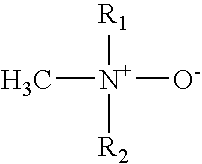Topical anesthetic composition
a topical anesthetic and composition technology, applied in the field of topical anesthetic composition, can solve the problems of difficult or dangerous administration, pose risks to the animal, pain to the animal, etc., and achieve the effect of improving dry or damaged skin, enhancing the stability of the vasoconstrictor
- Summary
- Abstract
- Description
- Claims
- Application Information
AI Technical Summary
Benefits of technology
Problems solved by technology
Method used
Image
Examples
example 1
Formulation of a Topical Anesthetic Gel
[0093] This example describes the preparation of a topical anesthetic composition in the form of a spray-on gel. The composition has the following formulation:
Purified water Sorbitol Liquid100.0mg / mL70% Non-CrystallizingLignocaine HCl40.0mg / mL (4%)Sodium Metabisulfite1.5mg / mLCetrimide0-5.0mg / mLAdrenaline Tartrate36.0μg / mL (1:2000)Hydroxy CelluloseQuantity to suit (q.s.)Food Dye (e.g. blue)q.s.Purified waterto 1mL
[0094] The composition is prepared by combining the above ingredients to achieve the required color and consistency as required. The composition is then placed within a suitable spray-on applicator. The composition is viscous and, when applied, is in the form of a “sticky” gel.
[0095] Sorbitol functions as a thickener and a humectant and keeps the gel “sticky” after application. Sodium metabisulfite prevents oxidation of the adrenalin. Cetrimide is an antiseptic as well as a surfactant and humectant. Hydroxy cellulose functions as a ...
example 2
Formulation of a Topical Anesthetic Gel Having a Long Duration of Action
[0098] This example describes the preparation of another topical anesthetic composition in the form of a spray-on gel and potentially having a longer duration of action than the composition of Example 1. The composition has the following formulation:
Purified water Sorbitol Liquid100.0mg / mL70% Non-CrystallizingLignocaine HCl50.0mg / mL (5%)Bupivacaine HCl5.0mg / mL (0.5%)Sodium Metabisulfite1.5mg / mLCetrimide0-5.0mg / mLAdrenaline Tartrate45.0μg / mLFood Dye (e.g. brilliant blue)q.s.Hydroxy Celluloseq.s.Purified waterto 1mL
[0099] The composition is prepared by combining the above ingredients to achieve the required color and consistency as required. The composition is then placed within a suitable spray-on applicator. Again, the composition is in the form of a “sticky” gel.
[0100] If desired, the composition can further comprise an anti-inflammatory agent, and / or an insecticide / insect repellent, and / or a skin penetrati...
example 3
Formulation of a Topical Anesthetic Crème Having a Long Duration of Action
[0101] This example describes the preparation of another topical anesthetic composition in the form of a spray-on crème. The composition has the following formulation:
Cetyl Alcohol78.00mg / mLParaffin Wax135.00mg / mLGlycerol75.00mg / mLLauryl Sulfate10.00mg / MIDyeq.s.Lignocaine HCl50.00mg / mLBupivacaine HCl5.00mg / mLSodium Metabisulfite1.50mg / mLCetrimide0-5.0mg / mLHydrochloric Acid 25%q.s.Adrenaline Acid Tartrate0.045mg / mLPurified Waterto 1mL
[0102] The composition is prepared by combining the above ingredients to achieve the required color and consistency as required. The composition is then placed within a suitable spray-on applicator. The composition is in the form of a “sticky” crème.
[0103] If desired, the composition can further comprise an anti-inflammatory agent, and / or an insecticide / insect repellent, and / or a skin penetrating enhancer, and / or a bittering agent.
PUM
| Property | Measurement | Unit |
|---|---|---|
| Fraction | aaaaa | aaaaa |
| Density | aaaaa | aaaaa |
| Density | aaaaa | aaaaa |
Abstract
Description
Claims
Application Information
 Login to View More
Login to View More - R&D
- Intellectual Property
- Life Sciences
- Materials
- Tech Scout
- Unparalleled Data Quality
- Higher Quality Content
- 60% Fewer Hallucinations
Browse by: Latest US Patents, China's latest patents, Technical Efficacy Thesaurus, Application Domain, Technology Topic, Popular Technical Reports.
© 2025 PatSnap. All rights reserved.Legal|Privacy policy|Modern Slavery Act Transparency Statement|Sitemap|About US| Contact US: help@patsnap.com

